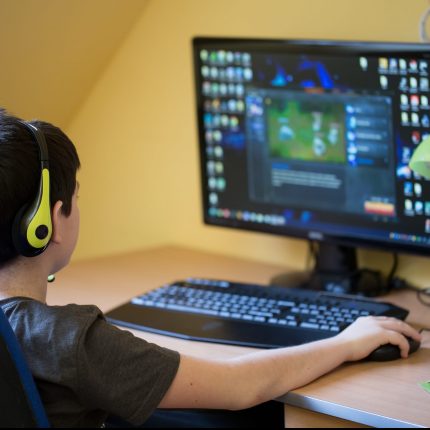Our society is becoming increasingly technological with each passing year. As technology develops, so do career opportunities for individuals interested in the computer field. There will always be a need for programmers, designers, and technicians. That begs the question, how are we as homeschoolers adjusting to incorporate our continually technology-based world? Are we working toward those opportunities, or are we rowing against them?
As we all know, summer is a great time to work on missed topics, subjects, or studies during the school year. However, it can be an especially good time for exploring something wholly new, such as technology for kids. Do you have any techie-talented children? If one or more of your kids have a natural inclination toward technology and computers, the summer may be a good chance for introducing computer programming. Perhaps they will love it, perhaps they won’t, but that’s what summer is for: experimenting!
5 Reasons to Choose Coding for Summer Learning
Coding, also known as computer programming, is one of the most lucrative careers currently. It is estimated that over one million coding jobs will be available by 2020. If you have a middle schooler or teen, just imagine how many technology careers may be possible by the time they graduate! Of course, we don’t want to push our kids into doing something merely for the career potential, but it’s a good benefit to keep in mind. Other than job opportunities, here are five more reasons why coding is a great choice for keeping away the summer slide this season.
- Learn more about the technology you use. This may seem obvious, but technology encompasses our daily lives. Coding teaches students the underlying language and information that makes every action and click possible. If we are going to depend on something for a major part of our lives, it’s a good idea to understand how it works, or at least in part.
- Coding develops new problem-solving perspectives. Coding requires a lot of critical thinking, which means it also strengthens those skills. Along those lines, critical thinking and coding both share a common process: make an attempt, get an error, try a different way, repeat until success is achieved. Due to that, coding teaches students to try different techniques and to keep an open mind regarding what may work.
- Parents and kids can learn together. Coding is something that people of any age can learn, which means you can learn a new skill with your child! Create a new bonding experience this summer by learning side-by-side. Everyone has to start from the beginning anyway, so it’s perfect to do together.
- Coding encourages creativity. With programming, every scenario is unique. Each project will be different and therefore require a different approach, process, and solution. Because of that, coding naturally encourages coders to think creatively as they work on a project or run into obstacles. These challenges can be frustrating, but they also help sharpen the mind and individuals will naturally approach other areas of life with a more creative perspective as a result.
- Coding may come in handy for other jobs than technical specialist positions. Perhaps your child is a natural at programming but isn’t very interested in the career. That’s fine! Did you know coding can help strengthen other skills and potential jobs? Just the coding knowledge can save future companies (or even entrepreneurs) thousands of dollars by writing their own scripts for websites, advertisements, webpage content, surveys, marketing and more. The bottom line: coding skills help employees become more valued team members.
5 Fun Coding Resources for Getting Started
Thankfully, there are several tools available for free programming for kids. As always, there are also other programs or courses which must be purchased and are more intensive or comprehensive. While not all of these options are free or for beginners, we found a few to help learners of most levels and budgets. Happy coding!
- Scratch. Scratch is probably one of the most well-known coding websites for kids. It’s perfect for beginners and younger children alike. This website makes computer programming extra fun and encourages kids to design through stories, games, and animations! Intermediate learners would likely do well with a more advanced program, but this is a great option for learning the basics!
- YouTube. There are a number of great YouTube videos and even entire channels dedicated to helping kids or adults learn to code. I recommend searching for a video that suits your needs, but from a quick search, Code Academy looks like it might be a good option. For younger students, however, perhaps individual videos geared toward kids would be more helpful.
- Coding for Kids (for Dummies). This book could definitely come in handy! I personally think this may be especially helpful for supplementing an online tool such as Scratch.
- CodaKid. With CodaKid, the computer programming courses are online-based. They offer a free trial, which sounds perfect for homeschooling families who are looking for a high-quality program, but are anxious about investing in something that their kid might not enjoy. CodeaKida offers coding courses, “quests,” and challenges to keep kids engaged and having fun. Their program includes Minecraft courses, game programming courses, specialty courses, and more!
- Code.org. This website has been around for a while as a well-known resource for teaching kids to code. Code.org is dedicated to expanding access to computer science and therefore offers free curriculum resources and courses. Everything is open sourced to help provide as much access as possible for students learning to code.
Courtney Newman
Courtney Newman is a homeschooled graduate with a love for writing. She is currently pursuing her undergraduate degree in Health Science at University of the People. Other than writing, her hobbies include reading, yoga, visiting the beach, and meditating. She lives with her husband and pets in coastal Virginia.
Latest Posts

This post is sponsored by Little Monsters Universe. I'm Tina Salmanowitz, an advocate for homeschooling and science education. With over a decade of experience as a science educator (in class…
Read more >
This post is sponsored by Time4Learning. Before the pandemic, it was business as usual for Boca Raton resident Nikki Warris. Her two daughters, 5-year-old Natalie and 8-year-old Lexi were…
Read more >
Are you a "Green Goddess" or a "Trash it Tom"? Recycling is an important thing we can all do to help preserve our environment. No doubt, you’ve heard the phrase “Reduce, Reuse, Recycle,”…
Read more >


